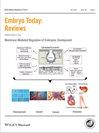Sara Ornaghi, Martin Mueller, Eytan R. Barnea, Michael J. Paidas
下载PDF
{"title":"Thrombosis during pregnancy: Risks, prevention, and treatment for mother and fetus—harvesting the power of omic technology, biomarkers and in vitro or in vivo models to facilitate the treatment of thrombosis","authors":"Sara Ornaghi, Martin Mueller, Eytan R. Barnea, Michael J. Paidas","doi":"10.1002/bdrc.21103","DOIUrl":null,"url":null,"abstract":"<p>Maternal thromboembolism and a spectrum of placenta-mediated complications including the pre-eclampsia syndromes, fetal growth restriction, fetal loss, and abruption manifest a shared etiopathogenesis and predisposing risk factors. Furthermore, these maternal and fetal complications are often linked to subsequent maternal health consequences that comprise the metabolic syndrome, namely, thromboembolism, chronic hypertension, and type II diabetes. Traditionally, several lines of evidence have linked vasoconstriction, excessive thrombosis and inflammation, and impaired trophoblast invasion at the uteroplacental interface as hallmark features of the placental complications. “Omic” technologies and biomarker development have been largely based upon advances in vascular biology, improved understanding of the molecular basis and biochemical pathways responsible for the clinically relevant diseases, and increasingly robust large cohort and/or registry based studies. Advances in understanding of innate and adaptive immunity appear to play an important role in several pregnancy complications. Strategies aimed at improving prediction of these pregnancy complications are often incorporating hemodynamic blood flow data using non-invasive imaging technologies of the utero-placental and maternal circulations early in pregnancy. Some evidence suggests that a multiple marker approach will yield the best performing prediction tools, which may then in turn offer the possibility of early intervention to prevent or ameliorate these pregnancy complications. Prediction of maternal cardiovascular and non-cardiovascular consequences following pregnancy represents an important area of future research, which may have significant public health consequences not only for cardiovascular disease, but also for a variety of other disorders, such as autoimmune and neurodegenerative diseases. Birth Defects Research (Part C) 105:209–225, 2015. © 2015 Wiley Periodicals, Inc.</p>","PeriodicalId":55352,"journal":{"name":"Birth Defects Research Part C-Embryo Today-Reviews","volume":"105 3","pages":"209-225"},"PeriodicalIF":0.0000,"publicationDate":"2015-09-25","publicationTypes":"Journal Article","fieldsOfStudy":null,"isOpenAccess":false,"openAccessPdf":"https://sci-hub-pdf.com/10.1002/bdrc.21103","citationCount":"5","resultStr":null,"platform":"Semanticscholar","paperid":null,"PeriodicalName":"Birth Defects Research Part C-Embryo Today-Reviews","FirstCategoryId":"1085","ListUrlMain":"https://onlinelibrary.wiley.com/doi/10.1002/bdrc.21103","RegionNum":0,"RegionCategory":null,"ArticlePicture":[],"TitleCN":null,"AbstractTextCN":null,"PMCID":null,"EPubDate":"","PubModel":"","JCR":"Q","JCRName":"Medicine","Score":null,"Total":0}
引用次数: 5
引用
批量引用
Abstract
Maternal thromboembolism and a spectrum of placenta-mediated complications including the pre-eclampsia syndromes, fetal growth restriction, fetal loss, and abruption manifest a shared etiopathogenesis and predisposing risk factors. Furthermore, these maternal and fetal complications are often linked to subsequent maternal health consequences that comprise the metabolic syndrome, namely, thromboembolism, chronic hypertension, and type II diabetes. Traditionally, several lines of evidence have linked vasoconstriction, excessive thrombosis and inflammation, and impaired trophoblast invasion at the uteroplacental interface as hallmark features of the placental complications. “Omic” technologies and biomarker development have been largely based upon advances in vascular biology, improved understanding of the molecular basis and biochemical pathways responsible for the clinically relevant diseases, and increasingly robust large cohort and/or registry based studies. Advances in understanding of innate and adaptive immunity appear to play an important role in several pregnancy complications. Strategies aimed at improving prediction of these pregnancy complications are often incorporating hemodynamic blood flow data using non-invasive imaging technologies of the utero-placental and maternal circulations early in pregnancy. Some evidence suggests that a multiple marker approach will yield the best performing prediction tools, which may then in turn offer the possibility of early intervention to prevent or ameliorate these pregnancy complications. Prediction of maternal cardiovascular and non-cardiovascular consequences following pregnancy represents an important area of future research, which may have significant public health consequences not only for cardiovascular disease, but also for a variety of other disorders, such as autoimmune and neurodegenerative diseases. Birth Defects Research (Part C) 105:209–225, 2015. © 2015 Wiley Periodicals, Inc.
妊娠期血栓形成:对母亲和胎儿的风险、预防和治疗——利用组学技术、生物标志物和体外或体内模型的力量促进血栓形成的治疗
母体血栓栓塞和一系列胎盘介导的并发症,包括先兆子痫综合征、胎儿生长受限、胎儿丢失和早剥,表现出共同的发病机制和易感危险因素。此外,这些产妇和胎儿并发症往往与随后的产妇健康后果有关,包括代谢综合征,即血栓栓塞、慢性高血压和II型糖尿病。传统上,一些证据表明血管收缩、过度血栓形成和炎症以及子宫-胎盘界面滋养细胞侵袭受损是胎盘并发症的标志特征。“组学”技术和生物标志物的发展在很大程度上是基于血管生物学的进步,对临床相关疾病的分子基础和生化途径的更好理解,以及越来越强大的大型队列和/或基于登记的研究。对先天免疫和适应性免疫的理解的进展似乎在几种妊娠并发症中起着重要作用。旨在改善这些妊娠并发症预测的策略通常是在妊娠早期使用子宫-胎盘和母体循环的无创成像技术结合血液动力学血流数据。一些证据表明,多标记方法将产生最好的预测工具,这可能反过来提供早期干预的可能性,以预防或改善这些妊娠并发症。妊娠后产妇心血管和非心血管后果的预测是未来研究的一个重要领域,这不仅对心血管疾病,而且对各种其他疾病,如自身免疫和神经退行性疾病,都可能产生重大的公共卫生后果。出生缺陷研究(C辑)105:209-225,2015。©2015 Wiley期刊公司
本文章由计算机程序翻译,如有差异,请以英文原文为准。

 求助内容:
求助内容: 应助结果提醒方式:
应助结果提醒方式:


